Getting Started with OpenDream
OpenDream is an online AI Image Generator that are available to all users. Our platform is designed to democratize graphic design and make it accessible to people of all skill levels, empowering them to express their creativity.
OpenDream offers a wide range of templates and design settings that can be easily customized to reflect your unique style and perspective, resulting in visually stunning content. So regardless of your experience level - whether you're a seasoned pro or a beginner - OpenDream is the ideal tool for bringing your creative ideas to life.
So start creating photos now with OpenDream with just a few clicks!
Step by Step to Use OpenDream
- Access to OpenDream. Go to the opendream.ai website. You can access the website by typing "opendream.ai" in your web browser's address bar or by clicking on a link to the website opendream.ai.
- Create Account Click the "Get Started" button to register an account. You can choose "Continue with Google" or "Continue with discord" to automatically join Opendream.ai.
- Select Template You have the option to select from a wide variety of templates that come equipped with preconfigured OpenDream settings, allowing you to effortlessly generate stunning images using a straightforward prompt.
- Styles "Style" encompasses the predefined prompts and negative prompts within the template's settings that users can personalize by adding or eliminating specific details. This customization enables users to achieve the desired stylistic outcome precisely.
- Enter the subject in the prompt box. At this step, you simply need to enter the subject in the prompt box. However, if you don't select the Opendream template, it's recommended to enter a complete prompt for the best results!
- Adjusting Parameters Guidance Scale, Step, and Sampler: It is recommended to keep them at their default settings.
- Model: Currently, OpenDream offers 4 models for you to choose from.
- Optional Number of Images: Users can generate up to 32 images at once (conditions apply for premium users).
- Aspect Ratio: Users can select the appropriate frame aspect ratio for their image usage.
- Additionally, you can choose whether the generated images are public or private.
- Click "Let's dream" to generate images
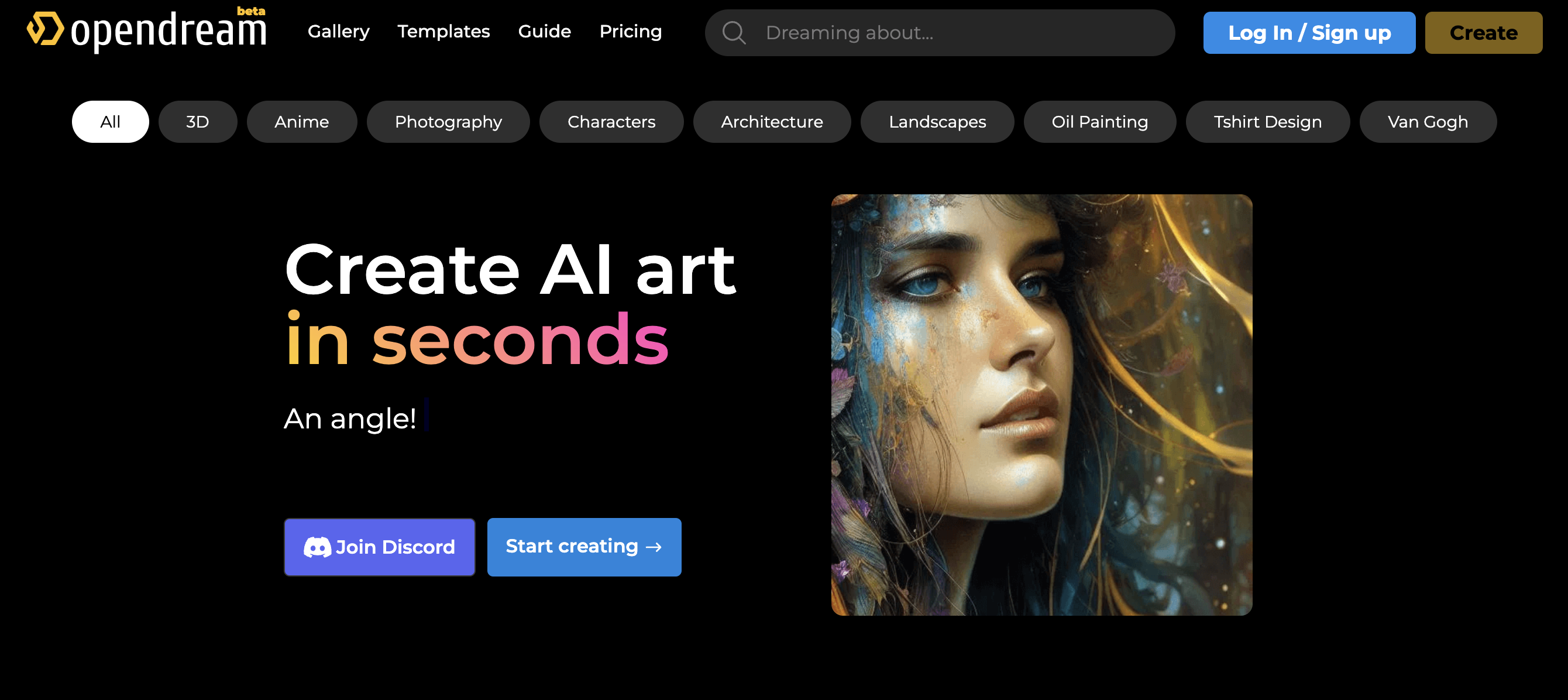
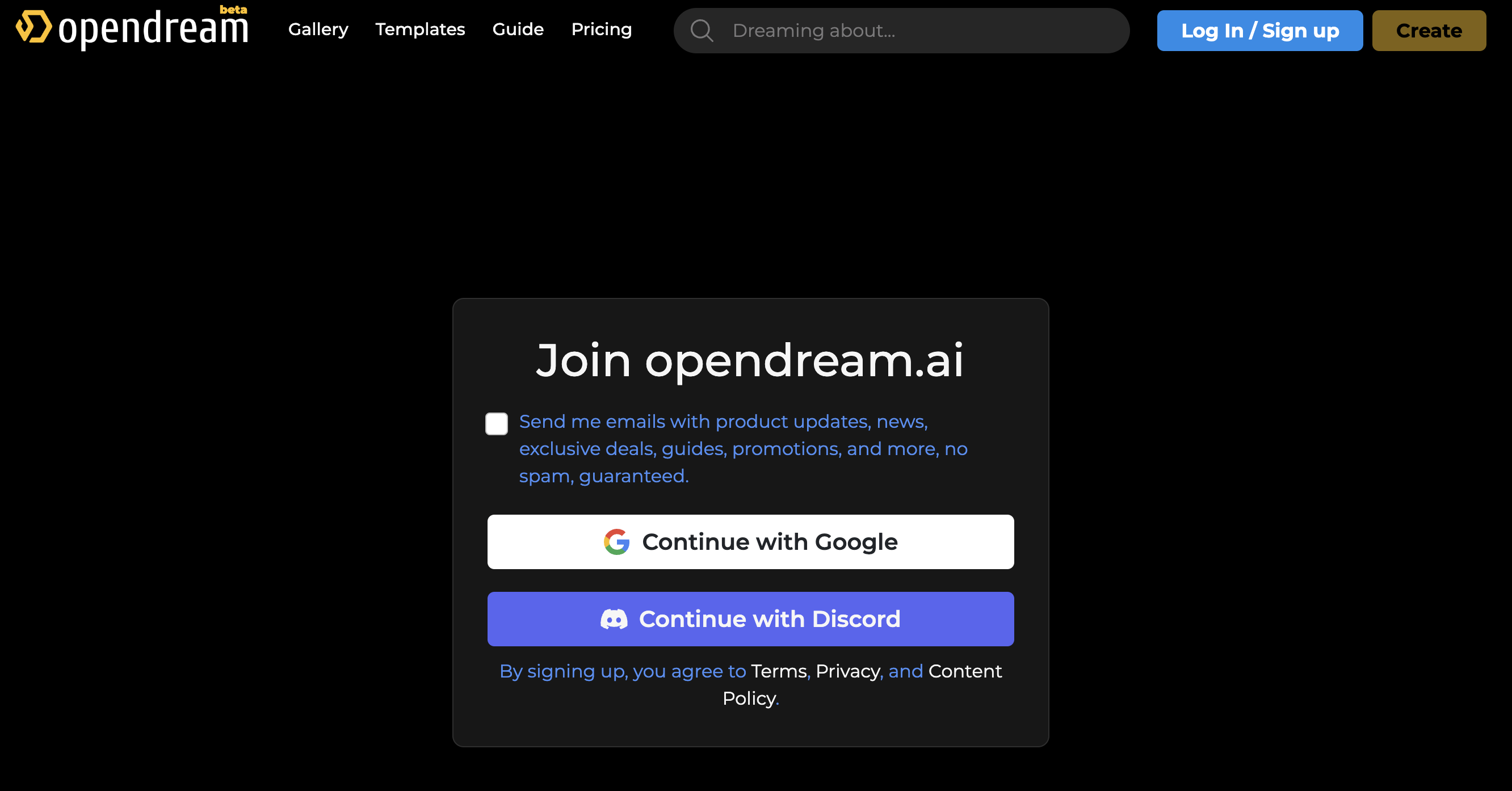
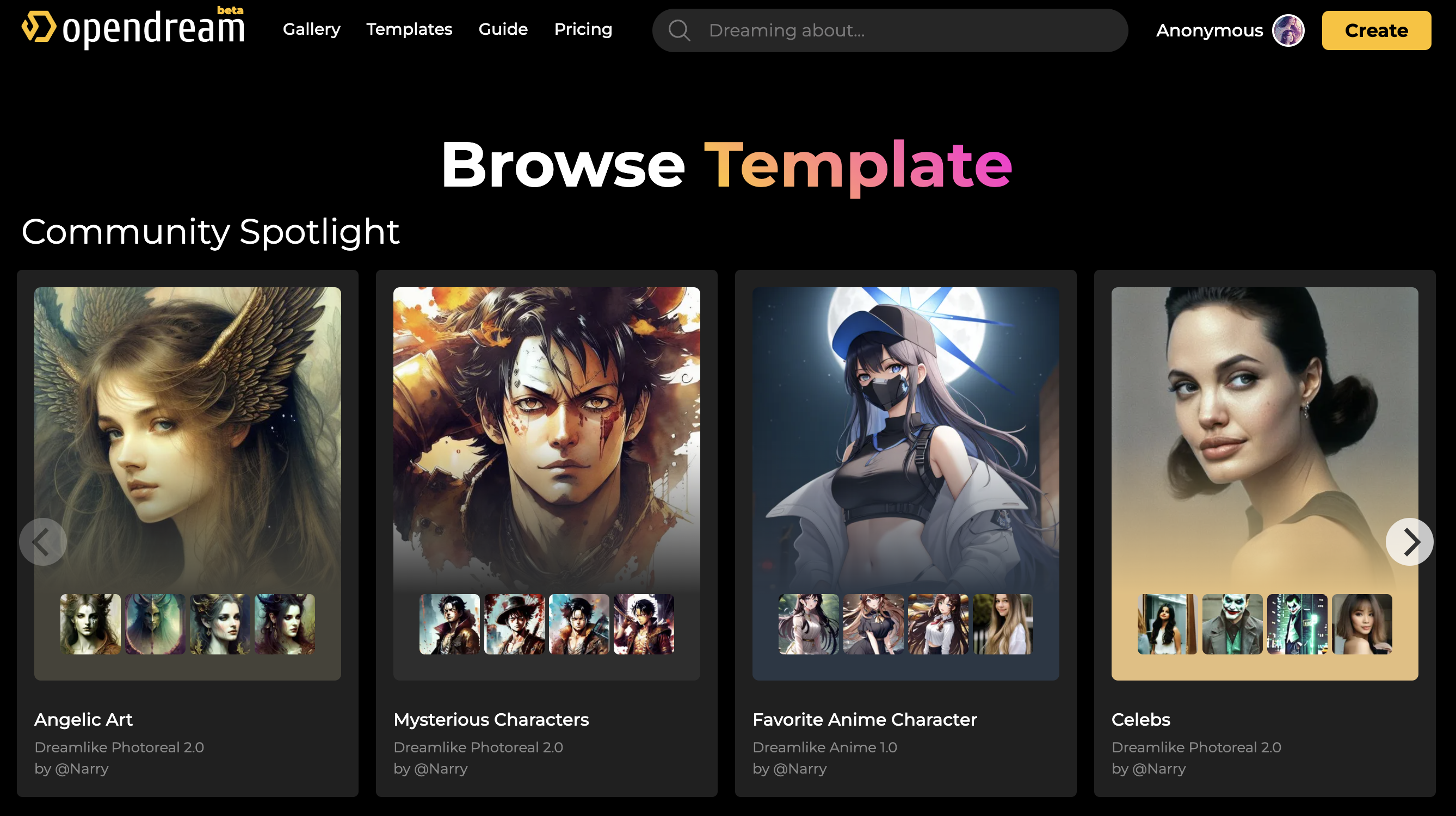
Note: In case you prefer not to create an image in a specific template offered by OpenDream, you can simply skip this step.
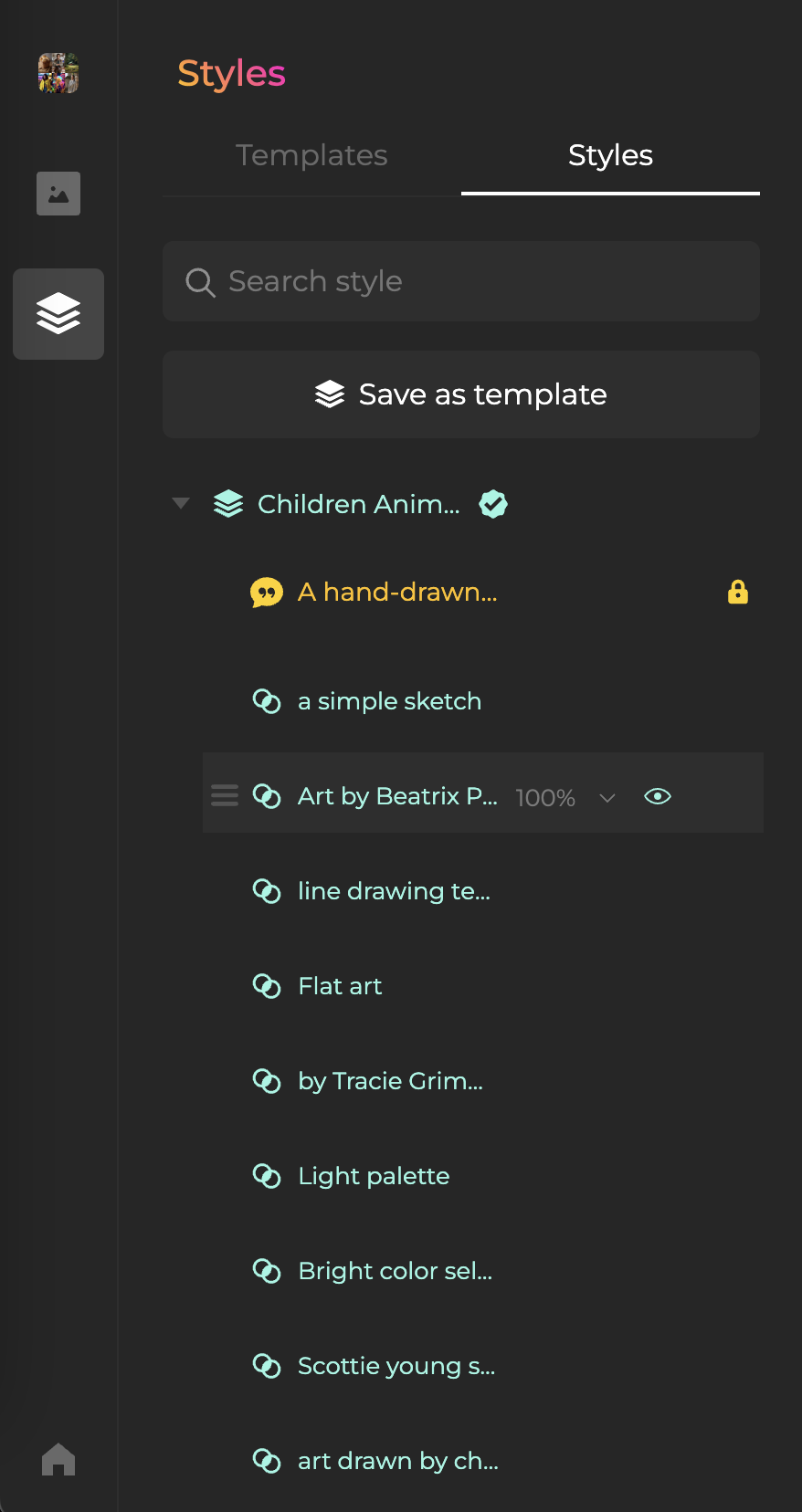
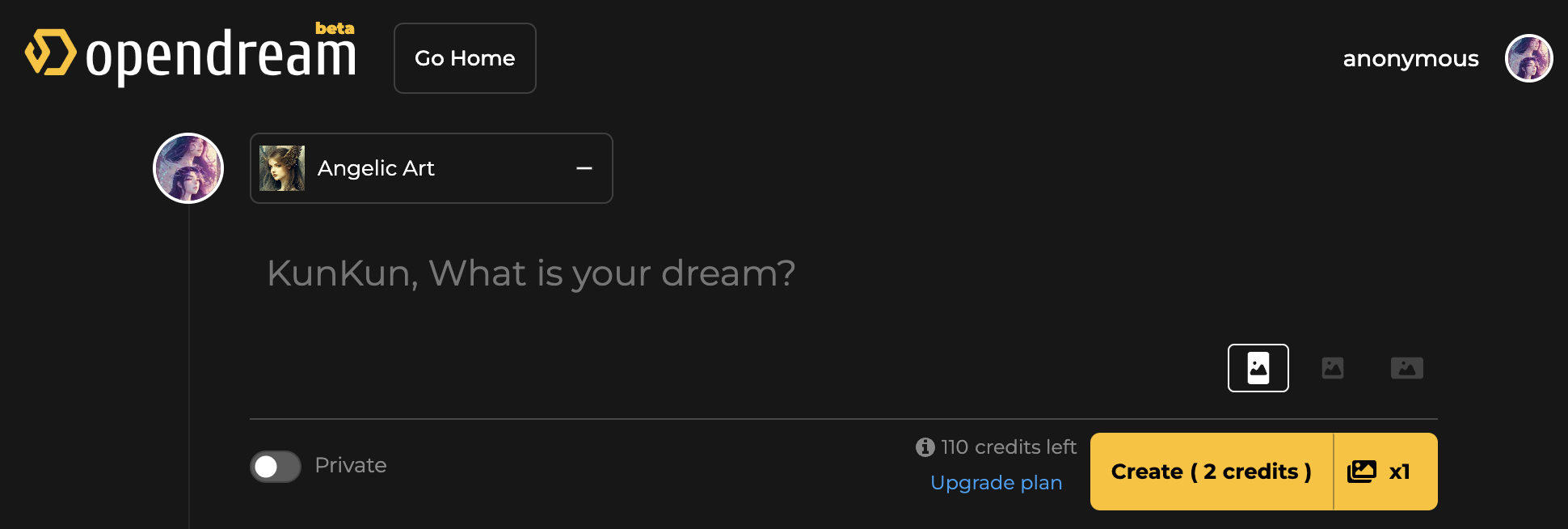
With the Free Plan, you can only generate a maximum of 1 image per creation and you can’t generate any images with NSFW prompt.
Note: Users can upload existing images to generate multiple variations of their existing images.
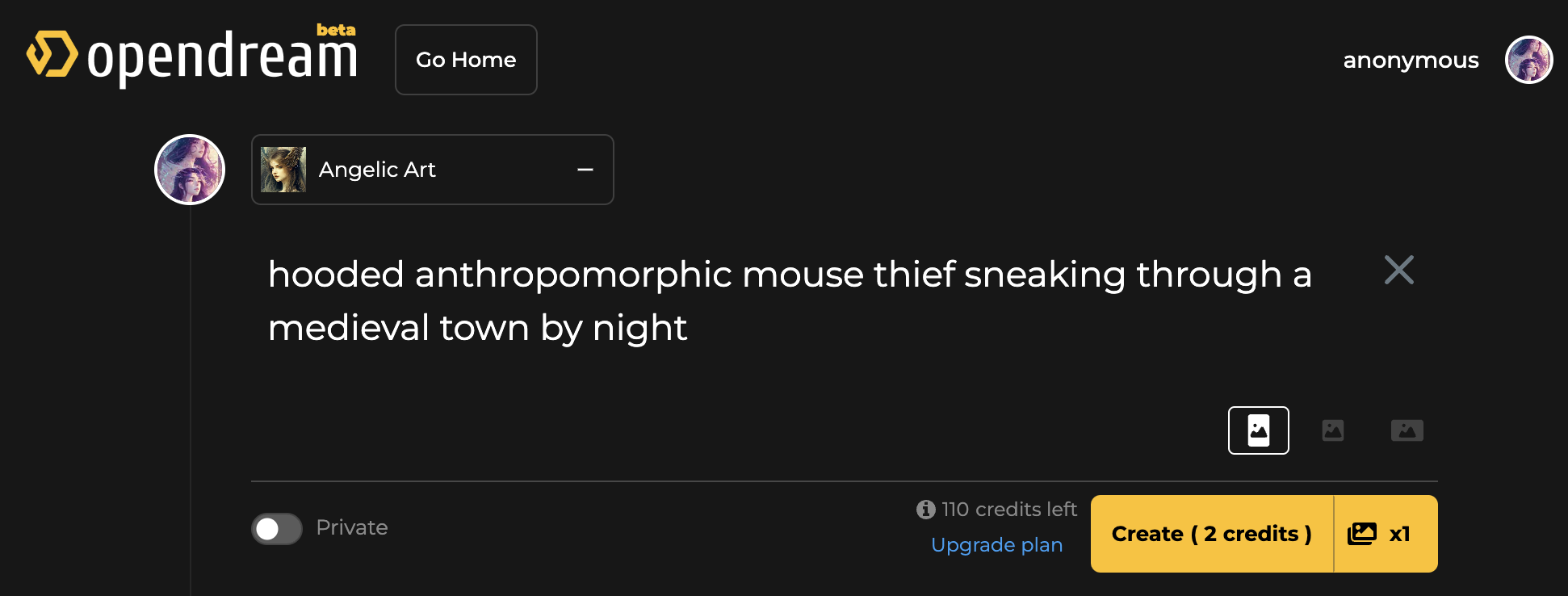
How to Write Good Prompts
Currently, OpenDream provides a wide range of templates for users who are not experienced in writing prompts. Users simply need to enter the desired subject in the prompt box and select a suitable template to generate beautiful images.
Select Template You have the option to select from a wide variety of templates that come equipped with preconfigured OpenDream settings, allowing you to effortlessly generate stunning images using a straightforward prompt.

For those who prefer to create their own images according to their own ideas and do not want to follow any predefined templates in OpenDream, they can refer to the instructions on how to create a good prompt:
1. Prompt
It's time to get started! While you'll eventually learn the best strategies for prompts, let's focus on the basics for now. The order of words in the prompt matters: Words at the beginning carry more weight than those at the end.
The limit to the number of words you can add to a prompt: Somewhere around 75 words. Get your creative juices flowing with this awesome prompt structure: [Art medium] -> [Objects] -> [Attribute] -> [Expression] -> [Lighting] -> [Details] -> [Camera Shot] -> [Media] -> [Engine]-> [Artist]. Congrats on your first AI-generated image! Let's have some fun and try these prompts:
- Change the lighting: sunrise, sunset, rainy, cinematic...
- Add details: intricate details, highly details, realistic - Try different mediums: oil painting, digital art, pixel art...
- Experiment with camera angles: low, eye level, high, and aerial...
- Add an engine (as in: a 3D rendering engine, if you want it to look more like a videogame): Unreal Engine, Octane render - Emulate an artist's style like Van Gogh or Studio Ghibli - Let's get creative and start making your images!
Punctuation - Which one should you use?
In prompts, ideas are usually separated by commas, although other symbols like pipes (|), colons (:), semicolons (;), and various symbols are also used by some individuals.
The choice of symbol doesn't significantly impact the results, as text encoders treat them similarly, resulting in minor variations. Feel free to use whichever symbol you prefer, and consider experimenting with different punctuation only for fine adjustments to your prompt
Resolution & aspect ratio might cause artifacts
Changing the height or width can lead to visual issues known as artifacts. These artifacts include odd duplications of body parts or people. This happens because the AI generator is not accustomed to portraits with elongated dimensions.
When generating images with a non-standard aspect ratio, it may require some trial and error. To minimize duplication problems, it is advisable to maintain a resolution of at least 512px for either the width or height.
For my preferred personal images, I opt for these options:
- For portrait, I use the size of 576*768 or the rectangular shape to get the best results.
- To generate a logo, I use the size of 512*512 or the square shape to get the best results.
- Landscape photo, I use the size of 768*576
Each image will require different size for the best quality without being cropped head or losing any details.
Another trick that I usually use to my prompt is: Choose the appropriate image size that fits and add style: Fit to the frames.
Let’s try again on OpenDream!
If you encounter duplicates, you can try incorporating phrases like "two faces," "two arms," "multiple people," and so on in your negative prompt. This tip can help reduce the occurrence of these artifacts.
Modifying the resolution alters the resulting output
It is crucial to understand that adjusting the height and width will impact the generated images.
In simpler terms, if all other factors remain the same (such as the prompt and seed), an image created at 512x512 will differ from one created at 512x768. This knowledge can be advantageous when fine-tuning your prompts.
How to add Prompt Weights
In OpenDream case, you just need to ajdust the percentage which is indicated after each style that you entered.
For general knowlegde, using parentheses () in the prompt amplifies the model's focus on the enclosed words, while square brackets [] diminish it.
Cheat sheet:
- a (word) - increase focus on word by a factor of 1.1
- a ((word)) - increase focus on word by a factor of 1.21 (= 1.1 * 1.1)
- a [word] - decrease focus on word by a factor of 1.1
- a (word:1.5) - increase focus on word by a factor of 1.5
- a (word:0.25) - decrease focus on word by a factor of 4 (= 1 / 0.25)
- a \(word\) - use literal () characters in the prompt
To specify a weight, use parentheses like this: (text:1.4). If no weight is specified, it is assumed to be 1.1. Weight specification only works with parentheses, not with square brackets [ ].
If you need to include literal () or [] characters in the prompt, use a backslash to escape them, for example: anime_\(character\).
Prompt libraries are essential for every proficient prompter.
As you progress and refine your skills, you'll come across remarkable prompts, ideas, and combinations that you wouldn't want to forget. If you're part of a team, sharing these discoveries with your colleagues can be incredibly valuable.
Consider your prompt library as your secret weapon, a place where you can cultivate your unique style and store your triumphs along the way. When it's time to generate a new concept, you can always refer back to what has proven successful in the past and replicate that success.
You've made significant progress! Now it's time for you to establish your own prompt library.
To make things easier for you, we've prepared a template. Just make a copy of the provided document and start filling it with your own discoveries as you embark on your prompting journey!
2. Negative Prompt
A negative prompt is the opposite of the prompt: Things you don't want to see in the generated image. All you have to do is jot down a list of things or styles that you absolutely do not want to see in your images.
These are must-use negative prompts, such as:
- lowes, text, error, missing fingers, fewer digits, cropped, extra digit, worst quality, mutated, low quality, jpeg artifacts, signature, bad anatomy, extra fingers, extra legs, extra arms, poorly drawn hands, poorly drawn feet, disfigured, tiling, bad art, out of frame, deformed, mutated, blurry, fuzzy, gross, misshaped, mutant, disgusting, ugly, watermark, watermarks.
- 2 heads, 2 faces, cropped image, out of frame, draft, twisted fingers, double image, long neck, malformed hands, multiple heads, extra limb, ugly, poorly drawn paws, missing limb, disfigured, cut-off, ugly, grain, low-res, Deformed, blurry, bad anatomy, disfigured, poorly drawn face, mutation, mutated, floating limbs, disconnected limbs, long body, disgusting, poorly drawn, mutilated, mangled, surreal, excessive fur, excessive body rolls extra fingers, morbid, gross proportions, missing arms, mutated hands, mutilated hands, cloned face, malformed, out of frame, clipped, cropped image, bad proportion, double, duplicated, deformed, disfigured, plastic, blurred, bad anatomy, ugly, grainy, low resolution, badly drawn face arms hands legs fingers, mutation, extra limb, missing limb, floating limbs, detached limbs, long neck body, out of focus, watermark, unproportional cat body.
Now please give it a try!
Get to know all OpenDream Parameters
Please carefully review the following parameters guide for best results:
The guidance scale parameter determines the degree to which the model obeys the user prompt, with a range of values from 1 to 50:
1: Mostly ignore the user prompt.
3: Be more creative.
7: Good balance between compliance with user prompts and creative freedom.
15: Comply with the prompt rather than freely.
Recommend: 7
Number of Images
This parameter indicates the number of images you want to create with each input prompt. You can create up to 32 images at a time. However, only premium users have the ability to create more than one image simultaneously.
Step
The denoising process requires a specific number of sampling steps. While increasing the number of steps can improve the quality of the output, it also prolongs the process.
Recommend: 25 sampling steps.
Sampler
Essentially, a sampler in OpenDream is an option that influences the generation process of images. It determines how the model progresses from noise to the desired image during each generation step.
To put it simply, different samplers can have varying effects on the resulting images. While some samplers produce similar outcomes, others can significantly alter the images generated. Some samplers may work better with fewer steps, while others may yield higher quality within a specific range of sampling steps.
In the following comparison, you will find various images generated using different samplers. The prompt, steps, and CFG scale are kept consistent for all images. Each column represents a distinct seed of the same prompt, and each row corresponds to a different sampler. By examining these examples, you can easily observe how the choice of sampler influences the output, assuming all other factors remain constant.
Now, let's focus on the main samplers and their impact on your image generations. I primarily utilize four samplers:
LMS
The Trusted and Reliable Option When using LMS with 50 steps, you can generally expect good results, provided that your prompt is well-crafted. This sampler operates efficiently, resulting in relatively quick outputs.
You can consistently maintain this setting at CFG 7-8 without encountering any problems. However, if the generated output appears unappealing, you might consider increasing the step value to around 80. Nonetheless, it's crucial to ensure that a higher step count truly improves the results rather than being a mere waste of time.
DDIM (Denoising Diffusion Probabilistic Model)
DDIM is a component of the original Latent Diffusion model, which served as the foundation for the development of Stable Diffusion. DDIM was initially implemented by CompVis and was the default setting in the earlier versions. It's worth noting that CompVis is a public research lab that collaborated with Stability AI and Runway to release the stable diffusion model.
DDIM is a versatile method that can perform effectively with both low and high step counts. It proves particularly useful when generating a large number of images efficiently. When experimenting with new prompt ideas, setting DDIM to a lower step count allows you to generate a batch of images quickly. This provides valuable insights into how your prompt performs across multiple seed variations, aiding in the evaluation and refinement of your creative concepts.
Euler A
The same principles that apply to DDIM also apply to this sampler. Similar to DDIM, this sampler exhibits remarkable speed and produces exceptional results when using low step counts (ranging from 8 to 16).
However, it also introduces significant changes in the style of generation. The output at 15 steps may differ greatly from the output at 16 steps, and both could be distinct from the result obtained at a step count of 30, and so on. Hence, this sampler is quite unpredictable in its behavior. It's important to note that the choice of sampler greatly influences the outcomes you obtain. Therefore, don't hesitate to experiment. If you achieved satisfactory results with k_euler_a, consider trying DDIM (or vice versa) to explore different possibilities.
Euler A closely resembles Euler in terms of the style and level of detail it can achieve in generated images.
The "A" stands for ancestral, indicating that it is not consistent, and altering the number of steps can lead to significant changes in the resulting image.
Despite this variability, Euler A performs exceptionally fast and can deliver impressive results even at very low step counts.
Euler
This sampler is considered one of the top models for generating intricate and visually appealing imagery. It offers a wide range of possibilities and excels in simulating fantasy-based artwork. The name "Euler" is derived from the renowned mathematician Leonhard Euler, known for his significant contributions to various fields of mathematics.
Account
1. How do I create an account?
To create an account on OpenDream:
- Visit the OpenDream website.
- Click on "Sign up" button
- You can choose "Continue with Google" or "Continue with discord" to automatically join Opendream.ai.
- Provide the required information (name, email, username,...)
- Click Save Change, then your account will be automatically logged in
For further help, consult the OpenDream website's support section or contact their customer support.
2. Can I change my login email?
No, currently it is not possible to change your login email.
3. Can I have multiple accounts with the same email address?
No, it is not possible to have multiple accounts with the same email address. Each email address can only be registered for one account.
4. How do I log into my account?
To log into your OpenDream account, follow these steps:
1: Go to the OpenDream website or open the mobile app;
2: Click on "Log In";
3: If you signed up for an account by email, select "Continue with Google". In case you registered an account through Discord, please select "Continue with discord";
4: You will be logged into your account immediately.
5. How can I update my account information (e.g., name, email, etc.)?
At present, it is not possible to modify your username or email once you have registered your account.
6. Is my personal information secure?
OpenDream prioritizes the security of your personal information. We use industry-standard measures to protect your data. We don't store your information beyond the session, and we cannot guarantee external platform security. If you have concerns, contact our support team.
7. Can I delete my account?
Yes, you have the option to delete your account. To proceed with the account deletion process, you can contact our support team, and they will assist you in deleting your account.
8. Can I change my account username?
Unfortunately, OpenDream does not currently support changing account usernames.
9. Can I link or unlink my account to/from other platforms (e.g., social media)?
Currently, users of OpenDream cannot link their accounts to other platforms. They can only share their created works from OpenDream on other social media platforms such as Facebook, Twitter, and Pinterest.
10. How do I manage my billing and payment information?
To manage your billing and payment information, you can access the "Billing" section. This section will provide you with all the necessary details regarding billing and payment.
11. What happens if I cancel my subscription?
When you cancel your subscription, you will still have the right to use all the credits you subscribed to previously. After using up the credits from your paid plan, your account will automatically downgrade to the free plan.
12. How can I report a problem or provide feedback about my account?
o report a problem or give feedback about your account, follow these steps:
1. Sign in to your OpenDream account;
2. Look for the "Help" or "Support" option;
3. Check the FAQs for a solution;
4. If not found, find the "Contact Us" section;
5. Describe your problem or feedback clearly send it to the support team at [email protected];
6. Submit and wait for a response from the support team.
13. Can I merge two separate accounts into one?
No, merging two separate accounts into one is not currently possible in OpenDream. Each account remains independent, and there is no feature to combine them. It is recommended to choose one account to use and manage your activities from that account.
14. How do I review my account activity or history?
All the images you create will be saved for you. To review your images along with the corresponding prompts and parameters, you can access your profile to view them.
15. Are there any restrictions on account usage or access?
No, there are no restrictions on account usage or access.
Subcription
1. Can I upgrade or downgrade my plan at any time?
Yes, absolutely! With OpenDream, you have the flexibility to upgrade or downgrade your plan at any time to suit your needs better. Whether you want to unlock additional features or adjust your subscription, our system allows for seamless plan changes. Simply reach out to our support team, and they will assist you in making the desired plan modification.
2. Is there a free trial available?
We do not offer a free trial for OpenDream. However, you can utilize our Free plan to experience the features and capabilities of OpenDream before deciding to upgrade to a paid plan.
3. How to control credits usage?
To control credit usage on OpenDream, we have provided clear notes regarding the number of credits required for generating photos. For instance, creating 1 image consumes 2 credits, while generating 4 images uses 8 credits, and more. By referring to this information, you can easily monitor and manage your credit usage. Rest assured, you can rely on these guidelines to effectively control your credit consumption.
4. What payment methods do you accept?
We accept payments through Stripe, providing you with a secure and convenient payment experience. Stripe supports major credit cards and popular digital wallets like Apple Pay and Google Pay. If you have any payment-related questions, contact our support [email protected] for further assistant.
5. Is there a discount for annual subscriptions?
Yes, we offer a 20% discount for users who opt for annual subscriptions.
6. Do you offer refunds or money-back guarantees?
Yes, you can request a refund. However, please note that refunds are only provided if you have not used or have used less than 2% of the credits included in the plan for which you made the payment.
7. Can I switch between pricing plans?
Absolutely! OpenDream allows users to switch between pricing plans, offering flexibility based on their needs. Whether upgrading for more features or downgrading to a basic plan, users can easily switch to align with their evolving requirements.
8. What happens if I exceed the limits of my chosen plan?
You will not be able to exceed the allocated number of credits provided. Once you consume all of them, your account will be downgraded to a free plan
9. Are there any hidden fees?
No, there are no hidden fees. The pricing for OpenDream is transparent and straightforward. You only pay for the services and features you choose to use, and there are no additional or hidden charges.
10. Do you offer enterprise or custom pricing for larger organizations?
Yes, we offer annual packages for larger organizations. Additionally, our support team can assist you with custom pricing options. Feel free to contact our support team for further assistance.
11. Can I transfer my subscription to another user or account?
No, it is not possible to transfer your subscription to another user or account. Each subscription is tied to the specific user or account that purchased it and cannot be transferred to a different individual or account. If another person wants to access the features of OpenDream, they would need to purchase their own subscription.
12. Can I downgrade my plan if I no longer need certain features?
Yes, you can modify your pricing plan by canceling your current subscription and switching to the desired pricing plan. Contact our team at [email protected] to get support!
Payment
1. My scheduled payment failed. How to re-try processing it?
To re-try a failed scheduled payment:
1. Check your payment method and update if needed;
2. Contact the payment processor for guidance;
3. Look for a "Retry"" or "Resubmit" button in your account settings;
4. Verify transaction details before re-trying;
5. Clear browser cache and cookies;
6. Contact customer support if issues persist.
2. What e-mail should I specify when making payment: the one attached to the OpenDream account or the one for billing/payer's one?
When making a payment for OpenDream, please provide the email address that you plan to use for logging in. This is the email that will be activated to grant you access. To ensure accuracy, it is advisable to clear your browser cache before making the payment to prevent any auto-fill errors with the email field.
If you prefer to receive invoices and billing notifications at a different email address, you can easily update this information later by contacting our support team and informing them of the change.
3. When will I be billed for my subscription?
The timing of your subscription billing depends on the payment terms and schedule set by OpenDream. It typically occurs on a recurring basis, such as monthly, quarterly, or annually. To get specific information about your billing schedule, refer to OpenDream's terms and conditions or contact OpenDream customer support.
4. Can I change my billing frequency (e.g., monthly, annually)?
Yes, you can change your billing frequency for OpenDream. We offer both monthly and annual options. Simply go to your account settings, navigate to the billing section, and select your desired frequency. Changes will take effect from the next billing cycle. Contact our customer support if you need further assistance.
5. Is there an option for automatic renewal?
Yes, there is an option for automatic renewal in OpenDream. Automatic renewal allows you to conveniently continue your subscription or service without the need for manual intervention. With this feature, you can ensure uninterrupted access to OpenDream and enjoy its benefits seamlessly. Automatic renewal can be set up during the initial subscription process or within your account settings.
6. Can I request a refund?
Yes, you can request a refund. However, please note that refunds are only provided if you have not used or have used less than 2% of the credits included in the plan for which you made the payment.
7. Do you offer discounts for annual payments?
Yes, we offer discounts for annual payments. Currently, we have a 20% off discount for the annual plan. This means that if you choose to pay for a full year upfront, you will receive a 20% reduction in the total cost compared to paying on a monthly basis. It's a great way to save money and enjoy the benefits of our services throughout the year.
8. How can I view my payment history or receipts?
To view your payment history or receipts on OpenDream, follow these steps:
1. Log in to your OpenDream account.
2. Go to the "Account" section.
3. Look for "Billing" and then click on it to access your payment history or receipts.
9. Can I transfer my subscription to another user or account?
No, it is not possible to transfer your subscription to another user or account. Each subscription is tied to the specific user or account that purchased it and cannot be transferred to a different individual or account. If another person wants to access the features of OpenDream, they would need to purchase their own subscription.
10. What currency is accepted for payments?
We accept payments in various currencies from across the globe, ensuring convenience for our valued customers. Our system is designed to seamlessly convert the value of these currencies into US dollars, providing a smooth transaction process.
11. Are there any taxes or additional charges applied to my payment?
No, there are no taxes or additional charges applied to your payment. The price you see is the total amount you will pay for the product or service.
12. How can I contact customer support for payment-related issues?
To contact customer support regarding payment-related issues, you can use the chat box available on our website or send an email to [email protected]. Our customer support team will be happy to assist you with any payment-related inquiries you may have.
13. Can I pause or temporarily suspend my subscription?
Yes, you can pause or temporarily suspend your OpenDream subscription. This allows you to take a break from the service without being billed during that period. The exact instructions to pause your subscription may vary, so it's best to refer to OpenDream's official documentation or contact their customer support for assistance.
14. Do you offer payment plans or installment options?
Yes, we offer payment plans and installment options for OpenDream. We have four pricing plan packages:
- Free: Forever free
- Essential: $9.90/mo
- Pro: $19.90/mo
- Annual: $189.90/year
Click on this link for details on each plan.
